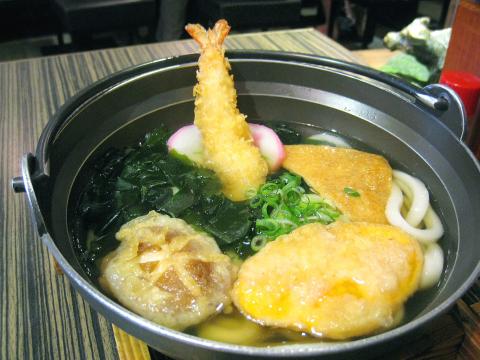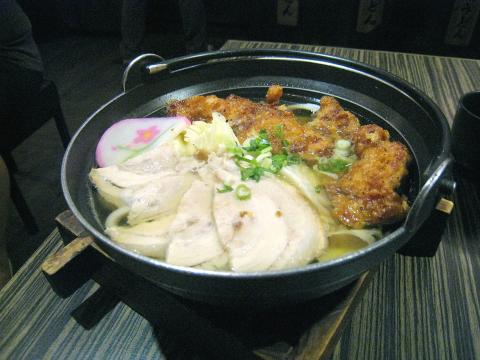With the recent opening of Hokkaido Ramen Santouka (山頭火, see the May 10, 2012, edition of the Taipei Times) and Ippudo TW (一風堂, see the May 17, 2012, edition), Taipei can officially be said to be in the grip of a ramen noodle craze. Both stores specialize in the serving of this Japanese-style noodle, and they have jointly raised the bar considerably for any establishment purporting to purvey Japanese style ramen. This fact underlines the suspicion long held that quality noodles are best obtained from shops specializing in the making and serving of a specific type of noodle.
The situation with ramen applies to other types of noodles as well. The best of various styles of northern Chinese-cut noodles (刀削麵), pulled noodles (拉麵), and southern-style egg noodles (雞蛋麵) are generally obtained from shops that make their own. If you are looking for a dish in which the noodle can stand up as the main event, mass-produced noodles just do not cut it.
With this in mind, I was particularly eager to check out Dosan Kanroku (土三寒六), a shop specializing in the Japanese udon noodle, and one that has been nominated by the Kagawa prefectural government as an “embassy for Japanese udon” (烏龍麵大使館), the official home of udon.

Photo: Ian Bartholomew, Taipei Times
My prior experience with udon in Taiwan had been of a flaccid noodle that failed to provide much interest in either taste or texture. They are a ubiquitous hot pot favorite, but one that I generally avoid as providing nothing more than a carbohydrate filler. As a result, my first experience of the cold udon noodles with salmon sashimi (NT$270 to NT$330) at Dosan Kanroku was a revelation. The noodles were fat and firm, with a robust texture that contrasted with their subtle flavor. You did not just slurp them in, but chewed them, coming to grips with their complex mix of qualities. Quite simply, these are exciting noodles. They’re made fresh daily, and can also be purchased for preparation at home (NT$180 a packet).
The bowl of udon with salmon sashimi was very simple, garnished with four thin slices of raw salmon that looked at first glance a trifle inadequate, but which proved sufficient flavor highlights to the noodles and the broth. I had requested the addition of a mountain yam (山藥) puree, a recommended optional extra (NT$50), and this provided an additional level of complexity.
The dish was a relatively new addition to the menu, and ideal for the current hot weather.

Photo: Ian Bartholomew, Taipei Times
The connoisseur’s udon (NT$260 to NT$290), a staple of the menu, which staff said was a favorite with Japanese guests, is also served cold, and includes a topping of tempura, including shrimp, mushroom, pumpkin, as well as tofu (there are seasonal variations to this combination). The mixture of slightly sweet tofu with the salty broth was a flavor combination that I associate very much with Japanese cuisine and one that is not altogether to my taste. It was telling that despite the lack of any instinctive fondness for this dish, the care in its preparation and the balancing of flavors was evident throughout, and it could be enjoyed for its pure craftsmanship.
Both the salmon and the connoisseur’s udon bowls were manifestly designed as “healthy cuisine.” They were low on oil and low on meat, and while this aspect of low-fat, low-calorie dining is something that Dosan Kanroku is keen to promote, there are plenty of hearty dishes that can fulfill the cravings of unrepentant carnivores. A fine example of this is the kingdom udon (NT$250 to NT$280), which is much the same udon bowl, served hot with a topping of roast fatty pork and deep fried chicken pieces.
The thin slices of roast pork were of superior quality, but not awe-inspiring, but the presence of large chucks of tender fried chicken, all crispy outside and falling apart within, were a benison to a hungry meat eater. Against the hot broth and the strong flavors of the meat the udon noodles manage to hold their own, but naturally do not have quite the pride of place they command in the cold dishes.
It should be noted that the broth in all these dishes has been carefully-crafted and is also one of the highlights of Dosan Kanroku’s udon dishes. The menu itself ranges widely, including various spicy or miso-enhanced options for those who prefer stronger flavors. A selection of rice dishes, including eel and salmon sashimi don (NT$350 and NT$230 respectively) are available, as are a variety of side dishes including nigiri sushi and tempura.
The atmosphere is casual and unfussy, and service by a team of young servers is quick, efficient and friendly, though occasionally a bit sloppy. The food itself, over a number of visits, was always impeccably presented. Udon noodles in Taipei clearly have a home; the only problem is that after visiting Dosan Kanroku, you will have very little tolerance for what passes for udon at many Japanese restaurants in Taipei.

That US assistance was a model for Taiwan’s spectacular development success was early recognized by policymakers and analysts. In a report to the US Congress for the fiscal year 1962, former President John F. Kennedy noted Taiwan’s “rapid economic growth,” was “producing a substantial net gain in living.” Kennedy had a stake in Taiwan’s achievements and the US’ official development assistance (ODA) in general: In September 1961, his entreaty to make the 1960s a “decade of development,” and an accompanying proposal for dedicated legislation to this end, had been formalized by congressional passage of the Foreign Assistance Act. Two

Despite the intense sunshine, we were hardly breaking a sweat as we cruised along the flat, dedicated bike lane, well protected from the heat by a canopy of trees. The electric assist on the bikes likely made a difference, too. Far removed from the bustle and noise of the Taichung traffic, we admired the serene rural scenery, making our way over rivers, alongside rice paddies and through pear orchards. Our route for the day covered two bike paths that connect in Fengyuan District (豐原) and are best done together. The Hou-Feng Bike Path (后豐鐵馬道) runs southward from Houli District (后里) while the

March 31 to April 6 On May 13, 1950, National Taiwan University Hospital otolaryngologist Su You-peng (蘇友鵬) was summoned to the director’s office. He thought someone had complained about him practicing the violin at night, but when he entered the room, he knew something was terribly wrong. He saw several burly men who appeared to be government secret agents, and three other resident doctors: internist Hsu Chiang (許強), dermatologist Hu Pao-chen (胡寶珍) and ophthalmologist Hu Hsin-lin (胡鑫麟). They were handcuffed, herded onto two jeeps and taken to the Secrecy Bureau (保密局) for questioning. Su was still in his doctor’s robes at

Mirror mirror on the wall, what’s the fairest Disney live-action remake of them all? Wait, mirror. Hold on a second. Maybe choosing from the likes of Alice in Wonderland (2010), Mulan (2020) and The Lion King (2019) isn’t such a good idea. Mirror, on second thought, what’s on Netflix? Even the most devoted fans would have to acknowledge that these have not been the most illustrious illustrations of Disney magic. At their best (Pete’s Dragon? Cinderella?) they breathe life into old classics that could use a little updating. At their worst, well, blue Will Smith. Given the rapacious rate of remakes in modern